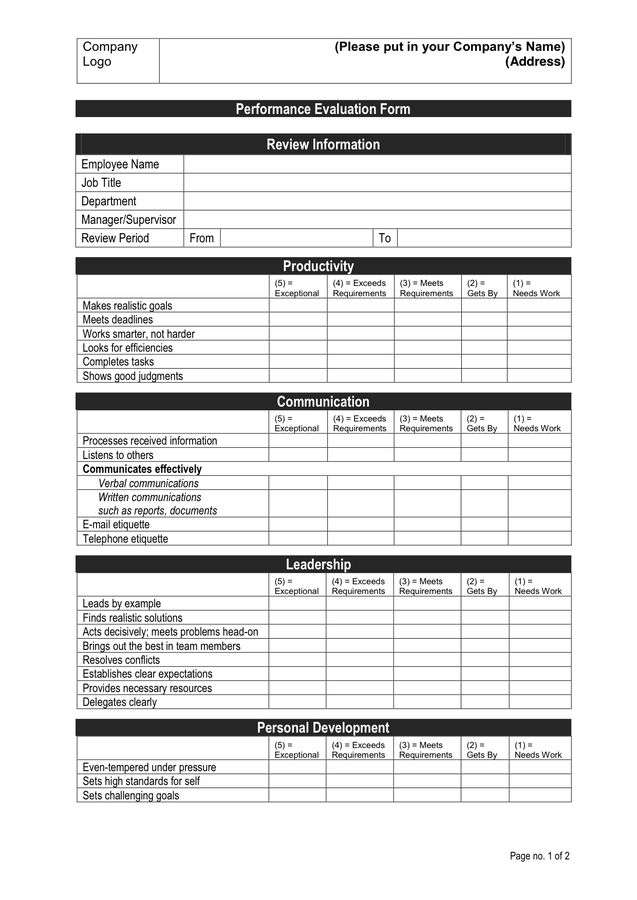The feedback for an employee performance evaluation is a vital component of any successful organization. It allows managers and supervisors to provide constructive criticism, praise, and guidance to their employees, ultimately leading to improved performance and overall success for the company.
In this article, we will explore the significance of employee performance evaluation feedback and how it can positively impact both individuals and the organization as a whole.

Why Employee Performance Evaluation Feedback Matters?
Employee performance evaluation feedback is crucial because it serves as a valuable tool for both employees and managers. It allows employees to understand their strengths and areas for improvement, while managers can provide guidance and support to help employees reach their full potential. Here are some key reasons why employee performance evaluation feedback matters:
- Improves Performance: Feedback helps employees understand how they are performing and what they can do to enhance their skills. It allows managers to identify areas where employees may need additional training or support.
- Boosts Morale: Positive feedback boosts employee morale and motivation. Recognizing their hard work and achievements can make employees feel valued and appreciated.
- Identifies Development Opportunities: Feedback helps employees identify areas where they can further develop their skills and knowledge. This can lead to personal and professional growth, benefiting both the individual and the organization.
- Strengthens Communication: Regular feedback sessions encourage open and honest communication between employees and managers. This fosters trust and transparency, creating a positive work environment.
- Aligns Goals: Feedback ensures that employees’ goals align with the overall goals of the organization. Managers can guide how employees’ performance contributes to the success of the company.
- Recognizes Achievements: Feedback allows managers to acknowledge and appreciate employees’ achievements, reinforcing positive behaviors and encouraging continued success.
- Identifies Performance Issues: Feedback provides an opportunity for managers to address any performance issues early on. This allows for timely interventions and corrective actions, preventing further decline in performance.
- Encourages Employee Engagement: Regular feedback sessions demonstrate that the organization values its employees’ growth and development. This promotes employee engagement and loyalty.
How to Provide Effective Employee Performance Evaluation Feedback
Providing effective employee performance evaluation feedback requires careful planning and consideration. Here are some tips to ensure your feedback is meaningful and impactful:
1. Be Specific and Objective
When providing feedback, be specific about the behavior or performance you are addressing. Avoid general statements and focus on tangible examples. Use objective language and avoid personal biases.
2. Use the Sandwich Technique
The sandwich technique involves framing constructive feedback between positive comments. Start with positive feedback, provide areas for improvement, and end with positive reinforcement. This approach helps employees feel valued and motivated.
3. Be Timely
Provide feedback as close to the observed behavior or performance as possible. Timely feedback allows employees to understand the context and make immediate adjustments if needed.
4. Focus on Behavior, Not Personality
When providing feedback, focus on specific behaviors or actions rather than personal characteristics. This helps employees understand what they need to change or improve without feeling attacked or criticized.
5. Encourage Two-Way Communication
Feedback should be a two-way conversation. Encourage employees to ask questions, share their perspectives, and provide input. This promotes a collaborative approach and fosters a sense of ownership in the feedback process.
6. Set Clear Goals and Expectations
Communicate performance expectations and set SMART (Specific, Measurable, Achievable, Relevant, Time-bound) goals. This helps employees understand what is expected of them and provides a clear framework for evaluation.
7. Provide Ongoing Support
Feedback should not be a one-time event. Continuously support and guide employees by offering resources, training, and mentoring opportunities. Regularly check in to monitor progress and provide additional feedback as needed.
The Benefits of Implementing Effective Employee Performance Evaluation Feedback
Implementing effective employee performance evaluation feedback can yield numerous benefits for both individuals and organizations. Here are some of the key advantages:
- Improved Performance: Clear feedback helps employees understand their strengths and areas for improvement, leading to enhanced performance.
- Enhanced Employee Engagement: Regular feedback sessions promote employee engagement and motivation, resulting in higher productivity and job satisfaction.
- Increased Retention: When employees feel valued and supported through feedback, they are more likely to stay with the organization long-term.
- Identified Training Needs: Feedback allows managers to identify training needs and provide the necessary resources for employees to develop their skills.
- Improved Communication: Effective feedback fosters open communication and trust between employees and managers, creating a positive work environment.
- Higher Quality Work: When employees receive regular feedback, they can make necessary adjustments to produce higher quality work and achieve better results.
Conclusion
Employee performance evaluation feedback is an essential aspect of organizational success. It helps employees grow, develop, and align their goals with those of the organization. Effective feedback fosters open communication, boosts morale, and leads to improved overall performance. By implementing regular feedback practices, organizations can create a culture of continuous improvement and support their employees in reaching their full potential.